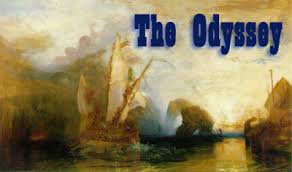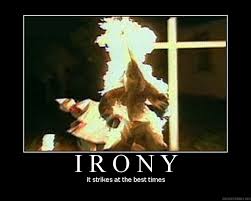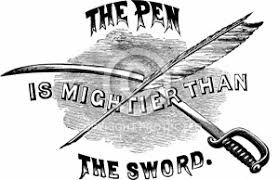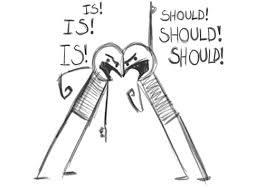31. Dialect: the language of a particular district, class, or group of persons; the sounds, grammar, and diction employed by people distinguished from others
http://www.youtube.com/watch?v=l9oIvsk7cvw&feature=player_detailpage
32. Dialectics: formal debates usually over the nature of truth
http://www.youtube.com/watch?feature=player_detailpage&v=t1Lo3P-Dp4Y
33. Dichotomy: split or break between two opposing things
34. Diction: the style of speaking or writing as reflected in the choice and use of words
http://www.youtube.com/watch?v=bhR1nJ1oY9M&feature=player_detailpage
35. Didactic: having to do with the transmission of information; education
36. Dogmatic: rigid in beliefs and principles
37. Elegy: a mournful, melancholy poem, especially a funeral song or lament for the dead, sometimes contains general reflections on death, often with a rural or pastoral setting.
http://www.youtube.com/watch?v=Ov4I4k3vV3M
Epic: a long narrative poem unified by a hero who reflects
the customs, mores, and aspirations of his nation of race as he makes his way
through legendary and historic exploits, usually over a long period of time
(definition bordering on circumlocution).

Epigram: witty aphorism.
Epitaph: any brief inscription in prose or verse on a tombstone; a short formal poem of commemoration often a credo written by the person who wishes it to be on his tombstone.
Epithet: a short, descriptive name or phrase that may insult someone’s character,
characteristics

Euphemism: the use of an indirect, mild or vague word or
expression for one thought to be coarse, offensive, or blunt.

Evocative (evocation): a calling forth of memories and
sensations; the suggestion or production through artistry and imagination of a
sense of reality.Exposition: beginning of a story that sets forth facts, ideas, and/or characters, in a detailed explanation.
Expressionism: movement in art, literature, and music
consisting of unrealistic
representation of an inner idea or feeling(s).

Fallacy: from Latin word “to deceive”, a false or misleading
notion, belief, or argument; any kind of erroneous reasoning that makes
arguments unsound.

Falling Action: part of the narrative or drama after the
climax.

Figurative Language: apt and imaginative language
characterized by figures of speech (such as metaphor and simile).

Folk Tale: story passed on by word of mouth.

Free Verse: verse without conventional metrical pattern,
with irregular pattern or no rhyme.
 http://www.youtube.com/watch?v=sHE0wmgljco
http://www.youtube.com/watch?v=sHE0wmgljco
 http://www.youtube.com/watch?v=sHE0wmgljco
http://www.youtube.com/watch?v=sHE0wmgljco
Genre: a category or class of artistic endeavor having a
particular form, technique, or content.

Gothic Tale: a style in literature characterized by gloomy
settings, violent or grotesque action, and a mood of decay, degeneration, and
decadence.

Hyperbole: an exaggerated statement often used as a figure
of speech or to prove a point.

Implication: a meaning or understanding that is to be arrive
at by the reader but that is not fully and explicitly stated by the author.

Incongruity: the deliberate joining of opposites or of
elements that are not appropriate to each other.

Inference: a judgement or conclusion based on evidence
presented; the forming of an opinion which possesses some degree of probability
according to facts already available.

Irony: a contrast or incongruity between what is said and
what is meant, or what is expected to happen and what actually happens, or what
is thought to be happening and what is actually happening.

Interior Monologue: a form of writing which represents the
inner thoughts of a character; the recording of the internal, emotional
experience(s) of an individual; generally the reader is given the impression of
overhearing the interior monologue.

Inversion: words out of order for emphasis.

Juxtaposition: the intentional placement of a word, phrase,
sentences of paragraph to contrast with another nearby.

Lyric: a poem having musical form and quality; a short
outburst of the author’s innermost thoughts and feelings.

Magic(al) Realism: a
genre developed in Latin America which juxtaposes the everyday with the marvelous or magical.

Metaphor(extended, controlling, and mixed): an analogy that
compare two different things imaginatively.

Extended: a metaphor that is extended or developed as far as
the writer wants to take it.

Controlling: a metaphor that runs throughout the piece of
work.

Mixed: a metaphor that ineffectively blends two or more
analogies.

Metonymy: literally
“name changing” a device of figurative language in which the name of an
attribute or associated thing is substituted for the usual name of a thing.

Mode of Discourse:
argument (persuasion), narration, description, and exposition.

Modernism: literary
movement characterized by stylistic experimentation, rejection of tradition,
interest in symbolism and psychology

Monologue: an
extended speech by a character in a play, short story, novel, or narrative
poem.
 http://www.youtube.com/watch?v=-JD6gOrARk4
http://www.youtube.com/watch?v=-JD6gOrARk4
 http://www.youtube.com/watch?v=-JD6gOrARk4
http://www.youtube.com/watch?v=-JD6gOrARk4
Mood: the
predominating atmosphere evoked by a literary piece.

Myth: a story, often about immortals, and sometimes connected with religious rituals, that attempts to give meaning to the mysteries of the world.
Narrative: a story or
description of events.

Omniscient Point of View:
knowing all things, usually the third person.

Oxymoron: a figure of speech in which two contradicting
words or phrases are combined to produce a rhetorical effect by means of a
concise paradox.

Pacing: rate of
movement; tempo.

Paradox: a statement
apparently self-contradictory or absurd but really containing a possible truth;
an opinion contrary to generally accepted ideas.

Parallelism: the principle in sentence structure that states
elements of equal function should have equal form.

Parody: an imitation
of mimicking of a composition or of the style of a well-known artist.

Personification: a figure of speech attributing human qualities to inanimate objects or abstract ideas.
Point of View: the attitude unifying any oral or written
argumentation; in description, the physical point from which the observer views
what he is describing.
Postmodernism: literature characterized by experimentation, irony, nontraditional forms, multiple meanings, playfulness and a blurred boundary between real and imaginary.
Protagonist: the central character in a work of fiction; opposes antagonist.
Realism: writing about the ordinary aspects of life in a straightfoward manner to reflect life as it actually is.
Requiem: any chant,
dirge, hymn, or musical service for the dead.

Rhetoric: use of language, both written and verbal in order to persuade.
Rhetorical Question: question suggesting its own answer or
not requiring an answer; used in argument or persuasion.

Rising Action: plot build up, caused by conflict and
complications, advancement towards climax.

Romanticism: movement
in western culture beginning in the eighteenth and peaking in the nineteenth
century as a revolt against Classicism; imagination was valued over reason and
fact.

Spiritual: a folk song, usually on a religious theme.
http://www.youtube.com/watch?v=QviNqBgArks ("Deep River" Song, spiritual)
Speaker: a narrator, the one speaking.

Stream of Consciousness: the style of writing that attempts
to imitate the natural flow of a character’s thoughts, feelings, reflections,
memories, and mental images, as the character experiences them.

Subordination: the couching of less important ideas in less
important structures of language.

Symbol: something which stands for something else, yet has a
meaning of its own.

Synecdoche: another form of name changing, in which a part
stands for the whole.


No comments:
Post a Comment